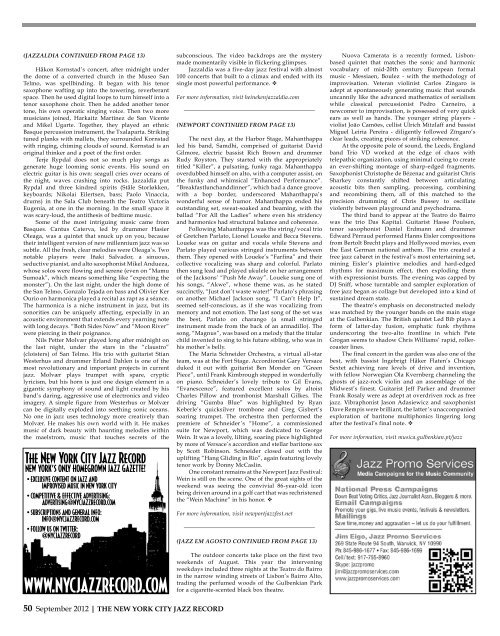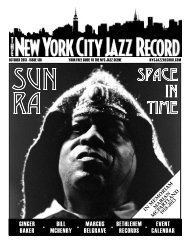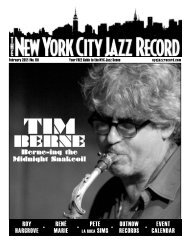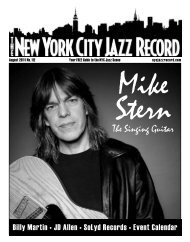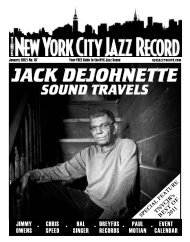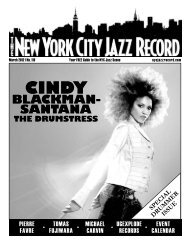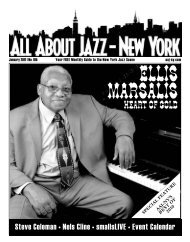September 2012 - The New York City Jazz Record
September 2012 - The New York City Jazz Record
September 2012 - The New York City Jazz Record
You also want an ePaper? Increase the reach of your titles
YUMPU automatically turns print PDFs into web optimized ePapers that Google loves.
(JAZZALDIA CONTINUED FROM PAGE 13)<br />
Håkon Kornstad’s concert, after midnight under<br />
the dome of a converted church in the Museo San<br />
Telmo, was spellbinding. It began with his tenor<br />
saxophone wafting up into the towering, reverberant<br />
space. <strong>The</strong>n he used digital loops to turn himself into a<br />
tenor saxophone choir. <strong>The</strong>n he added another tenor<br />
tone, his own operatic singing voice. <strong>The</strong>n two more<br />
musicians joined, Harkaitz Martínez de San Vicente<br />
and Mikel Ugarte. Together, they played an ethnic<br />
Basque percussion instrument, the Txalaparta. Striking<br />
tuned planks with mallets, they surrounded Kornstad<br />
with ringing, chiming clouds of sound. Kornstad is an<br />
original thinker and a poet of the first order.<br />
Terje Rypdal does not so much play songs as<br />
generate huge looming sonic events. His sound on<br />
electric guitar is his own: seagull cries over oceans of<br />
the night, waves crashing into rocks. <strong>Jazz</strong>aldia put<br />
Rypdal and three kindred spirits (Ståle Storløkken,<br />
keyboards; Nikolai Eilertsen, bass; Paolo Vinaccia,<br />
drums) in the Sala Club beneath the Teatro Victoria<br />
Eugenia, at one in the morning. In the small space it<br />
was scary-loud, the antithesis of bedtime music.<br />
Some of the most intriguing music came from<br />
Basques. Cantus Caterva, led by drummer Hasier<br />
Oleaga, was a quintet that snuck up on you, because<br />
their intelligent version of new millennium jazz was so<br />
subtle. All the fresh, clear melodies were Oleaga’s. Two<br />
notable players were Iñaki Salvador, a sinuous,<br />
seductive pianist, and alto saxophonist Mikel Andueza,<br />
whose solos were flowing and serene (even on “Mamu<br />
Sumoak”, which means something like “expecting the<br />
monster”). On the last night, under the high dome of<br />
the San Telmo, Gonzalo Tejada on bass and Olivier Ker<br />
Ourio on harmonica played a recital as rapt as a séance.<br />
<strong>The</strong> harmonica is a niche instrument in jazz, but its<br />
sonorities can be uniquely affecting, especially in an<br />
acoustic environment that extends every yearning note<br />
with long decays. “Both Sides Now” and “Moon River”<br />
were piercing in their poignance.<br />
Nils Petter Molvær played long after midnight on<br />
the last night, under the stars in the “claustro”<br />
(cloisters) of San Telmo. His trio with guitarist Stian<br />
Westerhus and drummer Erland Dahlen is one of the<br />
most revolutionary and important projects in current<br />
jazz. Molvær plays trumpet with spare, cryptic<br />
lyricism, but his horn is just one design element in a<br />
gigantic symphony of sound and light created by his<br />
band’s daring, aggressive use of electronics and video<br />
imagery. A simple figure from Westerhus or Molvær<br />
can be digitally exploded into seething sonic oceans.<br />
No one in jazz uses technology more creatively than<br />
Molvær. He makes his own world with it. He makes<br />
music of dark beauty with haunting melodies within<br />
the maelstrom, music that touches secrets of the<br />
<strong>The</strong> <strong>New</strong> <strong>York</strong> <strong>City</strong> <strong>Jazz</strong> <strong>Record</strong><br />
NEW YORK’S ONLY HOMEGROWN JAZZ GAZETTE!<br />
• EXCLUSIVE CONTENT ON JAZZ AND<br />
IMPROVISED MUSIC IN NEW YORK CITY<br />
• COMPETITIVE & EFFECTIVE ADVERTISING:<br />
ADVERTISING@NYCJAZZRECORD.COM<br />
• SUBSCRIPTIONS AND GENERAL INFO:<br />
INFO@NYCJAZZRECORD.COM<br />
• FOLLOW US ON TWITTER:<br />
@NYCJAZZRECORD<br />
www.nycjazzrecord.com<br />
50 <strong>September</strong> <strong>2012</strong> | THE NEW YORK CITY JAZZ RECORD<br />
subconscious. <strong>The</strong> video backdrops are the mystery<br />
made momentarily visible in flickering glimpses.<br />
<strong>Jazz</strong>aldia was a five-day jazz festival with almost<br />
100 concerts that built to a climax and ended with its<br />
single most powerful performance. v<br />
For more information, visit heinekenjazzaldia.com<br />
(NEWPORT CONTINUED FROM PAGE 13)<br />
<strong>The</strong> next day, at the Harbor Stage, Mahanthappa<br />
led his band, Samdhi, comprised of guitarist David<br />
Gilmore, electric bassist Rich Brown and drummer<br />
Rudy Royston. <strong>The</strong>y started with the appropriately<br />
titled “Killer”, a pulsating, funky raga. Mahanthappa<br />
overdubbed himself on alto, with a computer assist, on<br />
the funky and whimsical “Enhanced Performance”.<br />
“Breakfastlunchanddinner”, which had a dance groove<br />
with a bop border, underscored Mahanthappa’s<br />
wonderful sense of humor. Mahanthappa ended his<br />
outstanding set, sweat-soaked and beaming, with the<br />
ballad “For All the Ladies” where even his stridency<br />
and harmonics had structural balance and coherence.<br />
Following Mahanthappa was the string/vocal trio<br />
of Gretchen Parlato, Lionel Loueke and Becca Stevens.<br />
Loueke was on guitar and vocals while Stevens and<br />
Parlato played various stringed instruments between<br />
them. <strong>The</strong>y opened with Loueke’s “Farfina” and their<br />
collective vocalizing was sharp and colorful. Parlato<br />
then sung lead and played ukulele on her arrangement<br />
of the Jacksons’ “Push Me Away”. Loueke sung one of<br />
his songs, “Akwe”, whose theme was, as he stated<br />
succinctly, “Just don’t waste water!” Parlato’s phrasing<br />
on another Michael Jackson song, “I Can’t Help It”,<br />
seemed self-conscious, as if she was vocalizing from<br />
memory and not emotion. <strong>The</strong> last song of the set was<br />
the best, Parlato on charango (a small stringed<br />
instrument made from the back of an armadillo). <strong>The</strong><br />
song, “Magnus”, was based on a melody that the titular<br />
child invented to sing to his future sibling, who was in<br />
his mother’s belly.<br />
<strong>The</strong> Maria Schneider Orchestra, a virtual all-star<br />
team, was at the Fort Stage. Accordionist Gary Versace<br />
duked it out with guitarist Ben Monder on “Green<br />
Piece”, until Frank Kimbrough stepped in wonderfully<br />
on piano. Schneider’s lovely tribute to Gil Evans,<br />
“Evanescence”, featured excellent solos by altoist<br />
Charles Pillow and trombonist Marshall Gilkes. <strong>The</strong><br />
driving “Gumba Blue” was highlighted by Ryan<br />
Keberle’s quicksilver trombone and Greg Gisbert’s<br />
soaring trumpet. <strong>The</strong> orchestra then performed the<br />
premiere of Schneider’s “Home”, a commissioned<br />
suite for <strong>New</strong>port, which was dedicated to George<br />
Wein. It was a lovely, lilting, soaring piece highlighted<br />
by more of Versace’s accordion and stellar baritone sax<br />
by Scott Robinson. Schneider closed out with the<br />
uplifting “Hang Gliding in Rio”, again featuring lovely<br />
tenor work by Donny McCaslin.<br />
One constant remains at the <strong>New</strong>port <strong>Jazz</strong> Festival:<br />
Wein is still on the scene. One of the great sights of the<br />
weekend was seeing the convivial 86-year-old icon<br />
being driven around in a golf cart that was rechristened<br />
the “Wein Machine” in his honor. v<br />
For more information, visit newportjazzfest.net<br />
(JAZZ EM AGOSTO CONTINUED FROM PAGE 13)<br />
<strong>The</strong> outdoor concerts take place on the first two<br />
weekends of August. This year the intervening<br />
weekdays included three nights at the Teatro do Bairro<br />
in the narrow winding streets of Lisbon’s Bairro Alto,<br />
trading the perfumed woods of the Gulbenkian Park<br />
for a cigarette-scented black box theatre.<br />
Nuova Camerata is a recently formed, Lisbonbased<br />
quintet that matches the sonic and harmonic<br />
vocabulary of mid-20th century European formal<br />
music - Messiaen, Boulez - with the methodology of<br />
improvisation. Veteran violinist Carlos Zíngaro is<br />
adept at spontaneously generating music that sounds<br />
uncannily like the advanced mathematics of serialism<br />
while classical percussionist Pedro Carneiro, a<br />
newcomer to improvisation, is possessed of very quick<br />
ears as well as hands. <strong>The</strong> younger string players -<br />
violist João Camões, cellist Ulrich MitzIaff and bassist<br />
Miguel Leiria Pereira - diligently followed Zíngaro’s<br />
clear leads, creating pieces of striking coherence.<br />
At the opposite pole of sound, the Leeds, England<br />
band Trio VD worked at the edge of chaos with<br />
telepathic organization, using minimal cueing to create<br />
an ever-shifting montage of sharp-edged fragments.<br />
Saxophonist Christophe de Bézenac and guitarist Chris<br />
Sharkey constantly shifted between articulating<br />
acoustic bits then sampling, processing, combining<br />
and recombining them, all of this matched to the<br />
precision drumming of Chris Bussey to oscillate<br />
violently between playground and psychodrama.<br />
<strong>The</strong> third band to appear at the Teatro do Bairro<br />
was the trio Das Kapital. Guitarist Hasse Poulsen,<br />
tenor saxophonist Daniel Erdmann and drummer<br />
Edward Pérraud performed Hanns Eisler compositions<br />
from Bertolt Brecht plays and Hollywood movies, even<br />
the East German national anthem. <strong>The</strong> trio created a<br />
free jazz cabaret in the festival’s most entertaining set,<br />
mining Eisler’s plaintive melodies and hard-edged<br />
rhythms for maximum effect, then exploding them<br />
with expressionist bursts. <strong>The</strong> evening was capped by<br />
DJ Sniff, whose turntable and sampler exploration of<br />
free jazz began as collage but developed into a kind of<br />
sustained dream state.<br />
<strong>The</strong> theatre’s emphasis on deconstructed melody<br />
was matched by the younger bands on the main stage<br />
at the Gulbenkian. <strong>The</strong> British quintet Led Bib plays a<br />
form of latter-day fusion, emphatic funk rhythms<br />
underscoring the two-alto frontline in which Pete<br />
Grogan seems to shadow Chris Williams’ rapid, rollercoaster<br />
lines.<br />
<strong>The</strong> final concert in the garden was also one of the<br />
best, with bassist Ingebrigt Håker Flaten’s Chicago<br />
Sextet achieving rare levels of drive and invention,<br />
with fellow Norwegian Ola Kvernberg channeling the<br />
ghosts of jazz-rock violin and an assemblage of the<br />
Midwest’s finest. Guitarist Jeff Parker and drummer<br />
Frank Rosaly were as adept at overdriven rock as free<br />
jazz. Vibraphonist Jason Adasiewicz and saxophonist<br />
Dave Rempis were brilliant, the latter’s unaccompanied<br />
exploration of baritone multiphonics lingering long<br />
after the festival’s final note. v<br />
For more information, visit musica.gulbenkian.pt/jazz


